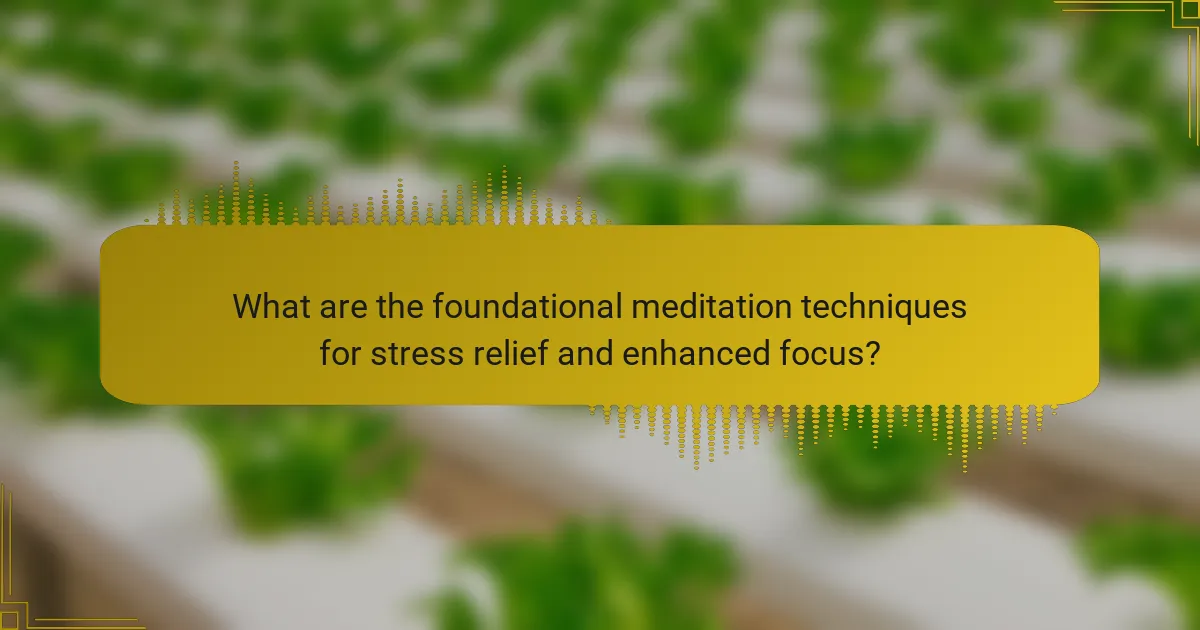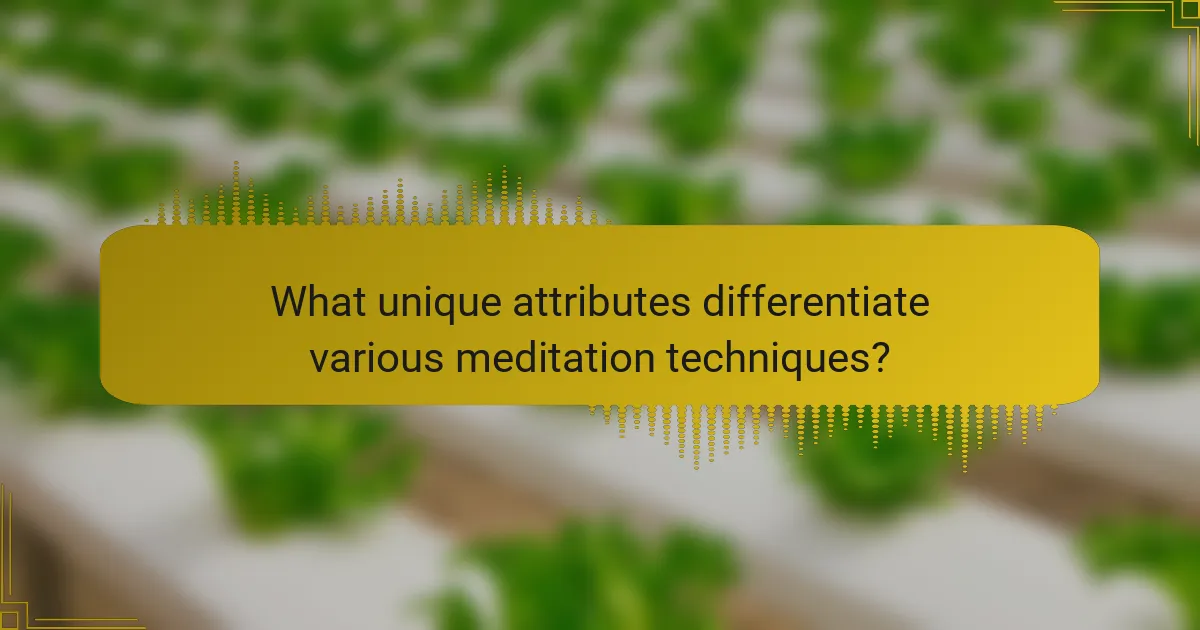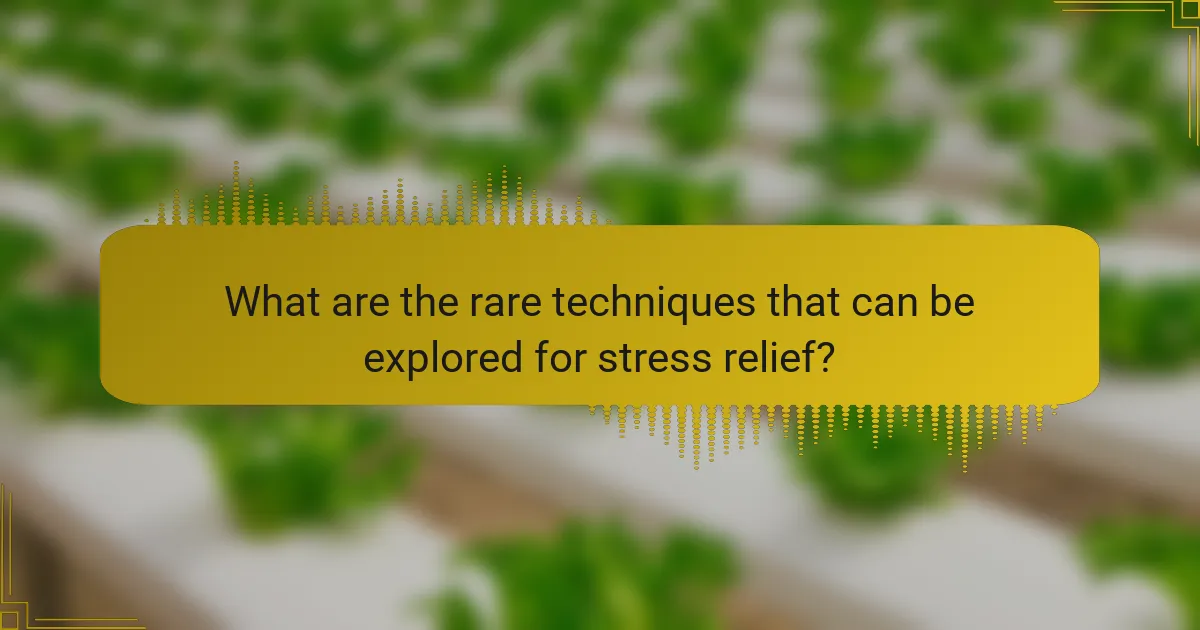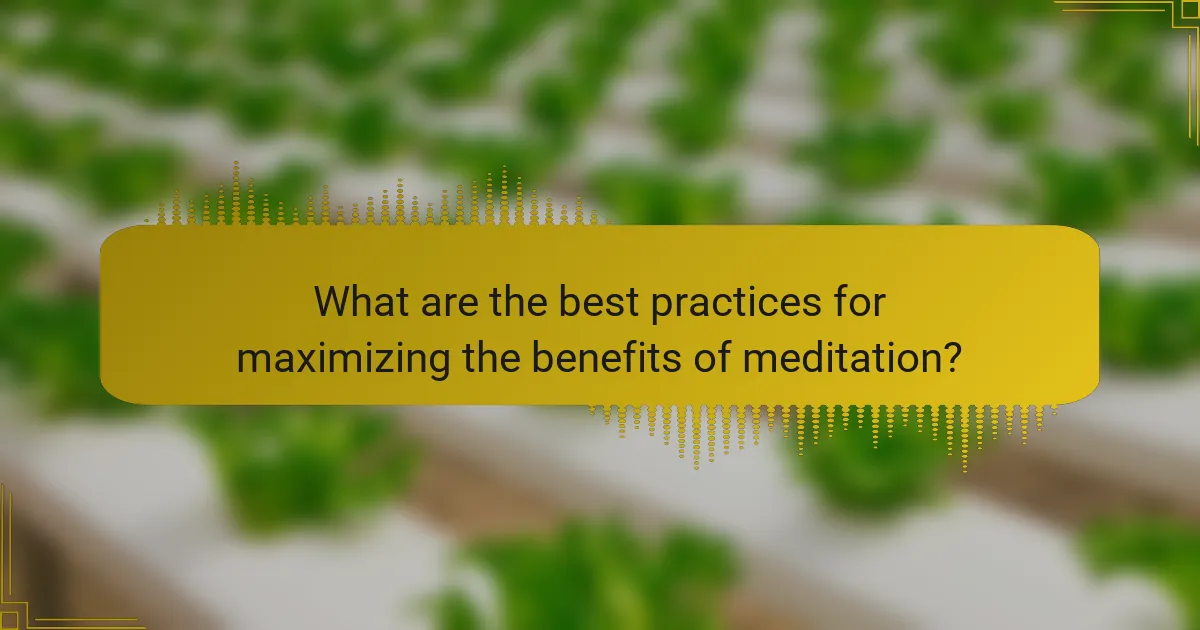Meditation techniques can significantly reduce stress and enhance focus. Key methods include mindfulness, breathing exercises, and guided visualization. Each technique offers unique attributes that cater to individual needs. Additionally, rare approaches like sound bath meditation and forest bathing provide alternative ways to promote relaxation and mental clarity.

What are the foundational meditation techniques for stress relief and enhanced focus?
Meditation techniques for stress relief and enhanced focus include mindfulness, breathing exercises, and guided visualization. Mindfulness promotes present-moment awareness, reducing anxiety and improving concentration. Breathing exercises, such as deep belly breathing, lower stress levels by activating the body’s relaxation response. Guided visualization helps in focusing the mind and creating a mental escape, enhancing overall mental clarity. Each technique can be practiced individually or combined for greater benefits.
How does breath awareness meditation help reduce stress?
Breath awareness meditation effectively reduces stress by promoting relaxation and enhancing focus. This technique encourages mindfulness, allowing individuals to become more attuned to their breathing patterns. As a result, it activates the body’s relaxation response, lowering cortisol levels and alleviating anxiety. Research indicates that consistent practice can lead to significant improvements in emotional well-being and stress management.
What are the steps to practice breath awareness meditation?
To practice breath awareness meditation, follow these steps:
1. Find a quiet space and sit comfortably with your back straight.
2. Close your eyes gently and take a few deep breaths to relax.
3. Bring your attention to your breath, noticing the inhalation and exhalation.
4. If your mind wanders, gently redirect your focus back to your breath.
5. Continue this practice for 5 to 10 minutes, gradually increasing the duration.
What role does body scan meditation play in enhancing focus?
Body scan meditation significantly enhances focus by promoting mindfulness and body awareness. This technique involves directing attention to various body parts, helping to ground thoughts and reduce distractions. As a result, practitioners often experience improved concentration and mental clarity. Research indicates that regular practice can lead to structural changes in the brain associated with attention and emotional regulation. This unique meditation form cultivates a heightened state of awareness, making it easier to maintain focus in daily tasks.
How can one effectively conduct a body scan meditation?
To effectively conduct a body scan meditation, find a quiet space, lie down comfortably, and close your eyes. Begin by focusing on your breath, inhaling deeply and exhaling slowly. Gradually bring your attention to each part of your body, starting from the toes and moving upward. Notice any sensations, tension, or discomfort without judgment. Spend a few moments on each area, allowing relaxation to flow through. As you complete the scan, take a moment to appreciate your body as a whole before gently returning your awareness to the present. This technique enhances focus and reduces stress by promoting mindfulness and body awareness.
How does loving-kindness meditation contribute to emotional well-being?
Loving-kindness meditation significantly enhances emotional well-being by fostering compassion and reducing negative emotions. This technique promotes positive feelings towards oneself and others, leading to increased emotional resilience. Research indicates that practitioners often experience lower levels of anxiety and depression, contributing to overall mental health. Additionally, loving-kindness meditation can improve social connections, enhancing feelings of belonging and support. Regular practice has been linked to lasting changes in brain regions associated with emotional regulation, highlighting its unique attribute of transforming emotional responses.
What are the key phrases to use in loving-kindness meditation?
Key phrases for loving-kindness meditation include “May I be happy,” “May I be healthy,” “May I be safe,” and “May I live with ease.” These phrases foster compassion and positive intentions towards oneself and others. Practicing these phrases can enhance emotional well-being and reduce stress.

What unique attributes differentiate various meditation techniques?
Various meditation techniques differ in their unique attributes, which influence their effectiveness for stress relief and enhanced focus. Techniques like mindfulness meditation emphasize present-moment awareness, while transcendental meditation uses mantras for deep relaxation. Guided meditation often incorporates visualizations, enhancing mental clarity. Zen meditation focuses on breathing and posture, promoting discipline. Each technique’s unique approach can cater to individual preferences and needs, making them suitable for different users.
How does guided visualization enhance mental clarity?
Guided visualization enhances mental clarity by focusing the mind and reducing distractions. This technique allows individuals to create mental images that promote relaxation and concentration. Studies indicate that engaging in guided visualization can improve cognitive function and decision-making skills. Additionally, it fosters a deeper connection between the mind and body, leading to enhanced overall mental performance.
What are common themes in guided visualization sessions?
Common themes in guided visualization sessions include relaxation, mental imagery, and emotional healing. These sessions often focus on stress reduction, enhancing focus, and promoting a sense of well-being. Participants visualize calming scenes or positive outcomes, which helps facilitate a deep state of relaxation. Additionally, themes may encompass self-discovery and personal growth, enabling individuals to explore their inner thoughts and feelings. Guided visualizations can also incorporate elements of mindfulness, encouraging present-moment awareness and connection with one’s emotions.
What makes transcendental meditation distinct in its approach?
Transcendental meditation is distinct due to its effortless technique and focus on mantra repetition. This approach promotes deep relaxation and reduces stress without requiring concentration. Practitioners often experience enhanced clarity and creativity, making it unique among meditation techniques. The method is designed for ease of practice, allowing individuals to integrate it into daily life seamlessly.
What are the specific mantras used in transcendental meditation?
Transcendental meditation uses specific mantras that are personalized for each practitioner. These mantras are typically simple, meaningless sounds or words that help focus the mind during meditation. The selection of mantras is often based on factors such as age, gender, and personal preference, ensuring a unique experience for each individual. The use of mantras aids in reducing stress and enhancing focus, making it an effective technique for mental clarity and relaxation.

What are the rare techniques that can be explored for stress relief?
Rare techniques for stress relief include sound bath meditation, forest bathing, and breathwork. These methods promote relaxation and mindfulness in unique ways. Sound bath meditation uses resonant sounds to induce a meditative state. Forest bathing immerses individuals in nature, enhancing mental well-being. Breathwork focuses on controlled breathing patterns, reducing anxiety and improving focus. Each technique offers a distinct approach to alleviating stress, making them valuable additions to traditional methods.
How can sound bath meditation be beneficial for focus?
Sound bath meditation enhances focus by promoting deep relaxation and reducing mental clutter. The soothing sounds create a tranquil environment that fosters mindfulness. This technique can lead to improved concentration and clarity. Regular practice may also enhance cognitive function, making it easier to maintain attention on tasks.
What instruments are typically used in sound bath sessions?
Sound bath sessions typically use instruments like singing bowls, gongs, chimes, and drums. These tools create sound vibrations that promote relaxation and mindfulness. Singing bowls, often made of crystal or metal, are particularly effective for their soothing tones. Gongs provide deep resonant sounds that can facilitate emotional release. Chimes add melodic layers, while drums can enhance rhythmic grounding. Each instrument contributes uniquely to the overall experience, making sound baths a holistic approach to stress relief and enhanced focus.
What are the benefits of using nature-based meditation techniques?
Nature-based meditation techniques offer numerous benefits for stress relief and enhanced focus. These methods promote relaxation, reduce anxiety, and improve mental clarity by connecting individuals with the natural environment.
Research indicates that spending time in nature can lower cortisol levels, a hormone associated with stress. Engaging in meditation outdoors can further amplify these effects, as the sounds and sights of nature enhance mindfulness practices.
Additionally, nature-based meditation fosters a sense of belonging and connection, which can lead to improved emotional well-being. The unique attribute of these techniques is their ability to harness the calming properties of natural settings, making meditation more effective for many individuals.
Incorporating nature into meditation can also provide a rare opportunity for sensory engagement, stimulating sight, sound, and smell, thus deepening the meditative experience.
How can one incorporate natural sounds into meditation practices?
Incorporating natural sounds into meditation practices enhances relaxation and focus. Use recordings of nature sounds like water streams, birds, or wind. These sounds create a calming atmosphere, helping to reduce stress and improve concentration. Experiment with different sounds to find what resonates with your meditation style. Consider using sound apps or playlists specifically designed for meditation.

What are the best practices for maximizing the benefits of meditation?
To maximize the benefits of meditation, practice regularly, choose a quiet space, and focus on your breath. Incorporate various techniques like mindfulness, loving-kindness, and guided imagery. Set specific intentions for each session to enhance your focus and reduce stress. Additionally, track your progress to identify what works best for you.
How can consistency improve the effectiveness of meditation practices?
Consistency significantly enhances the effectiveness of meditation practices by fostering deeper focus and stress relief. Regular meditation cultivates a habit, making it easier to enter a meditative state. This practice increases mindfulness, which is essential for reducing stress. Research indicates that consistent meditation can lead to structural changes in the brain, enhancing emotional regulation and focus. Moreover, maintaining a routine allows practitioners to track progress, reinforcing their commitment and motivation.
What common mistakes should be avoided when practicing meditation?
To enhance meditation practices, avoid common mistakes that hinder effectiveness. Neglecting a proper environment can distract from focus. Setting unrealistic expectations may lead to frustration. Skipping regular practice diminishes progress. Overthinking techniques can create unnecessary stress. Lastly, ignoring body signals can result in discomfort.
What expert insights can enhance meditation techniques for better focus?
Expert insights for enhancing meditation techniques focus on integrating mindfulness practices and structured routines. Regularly practicing focused breathing techniques can significantly improve concentration. Research indicates that meditative practices, like mindfulness meditation, can enhance cognitive functions and reduce stress levels. Additionally, incorporating visualization techniques can help maintain focus during sessions, allowing practitioners to visualize their goals or peaceful scenarios. Engaging in guided meditations can also provide a structured approach, making it easier to stay focused.